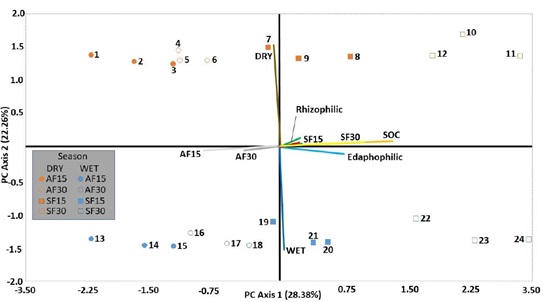Glomeromycotina Guild Spore Abundance Correlates with Soil Organic Carbon in Homegardens and Seasonal Forests in Yucatan, Mexico
DOI:
https://doi.org/10.28940/terra.v42i0.1812Keywords:
arbuscular mycorrhizal fungi, edaphophilic fungi, rhizophilic fungiAbstract
Soil organic carbon (SOC) is a key indicator of soil health. Arbuscular mycorrhizal fungi (AMF) have been shown to increase SOC and respond to SOC content, which in turn, is directly related to land use. We investigated the relationships between land use and Glomeromycotina AMF spore abundance of two AMF functional guilds, rhizophilic (having high root internal AMF hyphal length) and edaphophilic (with high external soil hyphal length) to SOC content in agroforestry systems (AS) and seasonal forest (SF) of Tzucacab, Yucatan, Mexico. Our results indicate greater SOC values in SF than AS of the same age with a trend of increasing SOC with system age. Rhizophilic spore abundance correlated with SOC content, showing dif ferences among land uses and system ages but not between seasons. No relationship was observed between edaphophilic spore abundance to SOC. Thus, we suggest that Glomeromicotyna spore abundance (measured at any time of the year) of rhizophilic fungi could be a good indicator of SOC and, a tool to monitor soil health due to land use changes.
Downloads
Publication Facts
Reviewer profiles N/A
Author statements
- Academic society
- Terra Latinoamericana
- Publisher
- Mexican Society of Soil Science, C.A.

















